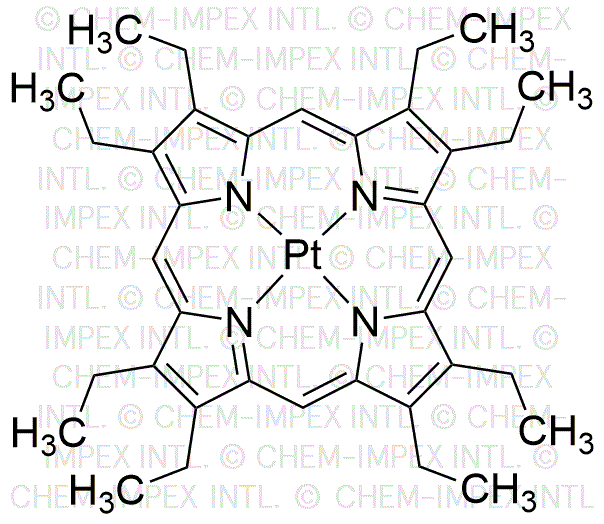Platinum(II) 2,3,7,8,12,13,17,18-(octaethyl)porphyrin is widely utilized in research focused on:
- Photodynamic Therapy: This compound is used in cancer treatment as a photosensitizer, helping to target and destroy cancer cells when exposed to light, offering a less invasive option compared to traditional therapies.
- Electrochemical Sensors: Its unique properties make it ideal for developing sensors that detect various biomolecules, enhancing the accuracy and sensitivity of diagnostics in medical and environmental applications.
- Solar Energy Conversion: The compound plays a role in the development of organic photovoltaic cells, contributing to more efficient solar energy harvesting and promoting sustainable energy solutions.
- Catalysis: It serves as a catalyst in various chemical reactions, improving reaction rates and selectivity in industrial processes, which can lead to cost savings and reduced waste.
- Material Science: Used in the synthesis of advanced materials, it aids in the creation of nanomaterials with unique optical and electronic properties, beneficial for electronics and nanotechnology applications.
General Information
Properties
Safety and Regulations
Applications
Platinum(II) 2,3,7,8,12,13,17,18-(octaethyl)porphyrin is widely utilized in research focused on:
- Photodynamic Therapy: This compound is used in cancer treatment as a photosensitizer, helping to target and destroy cancer cells when exposed to light, offering a less invasive option compared to traditional therapies.
- Electrochemical Sensors: Its unique properties make it ideal for developing sensors that detect various biomolecules, enhancing the accuracy and sensitivity of diagnostics in medical and environmental applications.
- Solar Energy Conversion: The compound plays a role in the development of organic photovoltaic cells, contributing to more efficient solar energy harvesting and promoting sustainable energy solutions.
- Catalysis: It serves as a catalyst in various chemical reactions, improving reaction rates and selectivity in industrial processes, which can lead to cost savings and reduced waste.
- Material Science: Used in the synthesis of advanced materials, it aids in the creation of nanomaterials with unique optical and electronic properties, beneficial for electronics and nanotechnology applications.
Documents
Safety Data Sheets (SDS)
The SDS provides comprehensive safety information on handling, storage, and disposal of the product.
Product Specification (PS)
The PS provides a comprehensive breakdown of the product’s properties, including chemical composition, physical state, purity, and storage requirements. It also details acceptable quality ranges and the product's intended applications.
Certificates of Analysis (COA)
Search for Certificates of Analysis (COA) by entering the products Lot Number. Lot and Batch Numbers can be found on a product’s label following the words ‘Lot’ or ‘Batch’.
*Catalog Number
*Lot Number
Certificates Of Origin (COO)
This COO confirms the country where the product was manufactured, and also details the materials and components used in it and whether it is derived from natural, synthetic, or other specific sources. This certificate may be required for customs, trade, and regulatory compliance.
*Catalog Number
*Lot Number
Safety Data Sheets (SDS)
The SDS provides comprehensive safety information on handling, storage, and disposal of the product.
DownloadProduct Specification (PS)
The PS provides a comprehensive breakdown of the product’s properties, including chemical composition, physical state, purity, and storage requirements. It also details acceptable quality ranges and the product's intended applications.
DownloadCertificates of Analysis (COA)
Search for Certificates of Analysis (COA) by entering the products Lot Number. Lot and Batch Numbers can be found on a product’s label following the words ‘Lot’ or ‘Batch’.
*Catalog Number
*Lot Number
Certificates Of Origin (COO)
This COO confirms the country where the product was manufactured, and also details the materials and components used in it and whether it is derived from natural, synthetic, or other specific sources. This certificate may be required for customs, trade, and regulatory compliance.


